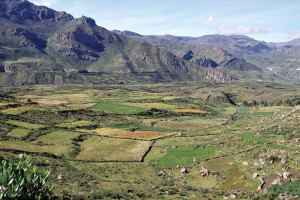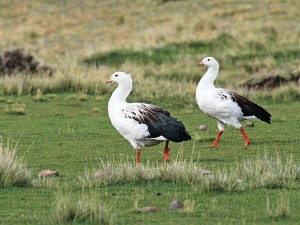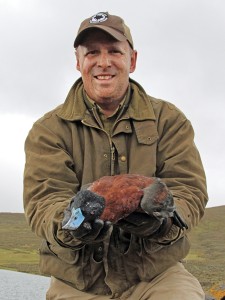May 29, 2013
By Ramsey Russell
 It's a fact we learned in kindergarten: water runs downhill. It collects in low-lying areas, forming wetlands. Generally speaking, it is there that waterfowl and waterfowl hunters alike spend favored days of their lives. But generally speaking, there are exceptions to every rule, and Peru's rugged Andes are such a place.
It's a fact we learned in kindergarten: water runs downhill. It collects in low-lying areas, forming wetlands. Generally speaking, it is there that waterfowl and waterfowl hunters alike spend favored days of their lives. But generally speaking, there are exceptions to every rule, and Peru's rugged Andes are such a place.
Leaving a small highland village well after daylight, we drove daily along rock-studded roads amid mountains that tower above the world's typical duck marshes. Past endless miles of stacked-stone walls that took centuries of ant-like labor to build, delineating the heavily terraced, panoramic landscape into cropped patches of traditional grains and tubers.
Or at higher elevations, containing long-since domesticated herds of indigenous alpacas and llamas that render the time-honored staples of fleece and flesh. Past a local populace with the sartorial inclination of traditional Andes herdsmen, that continues to cultivate crops with benign indifference to modern device, I saw neither a horse nor hand tool longer than a claw hammer. And yet, we were duck hunting.
The Rio de Colca originates at Lake Jayuchaca, situated 14,850 feet above sea level and derives water from an array of tributaries and low gradient marshlands of the Peruvian altiplano into which snowmelt from adjacent peaks feed. It was there, in the headwaters basin that my Peru duck hunting adventure began with a successful spot-and-stalk for a handsome pair of huallata, or Andean geese.
Advertisement
Further up-slope we drove past native herders tending their flocks and chinchilla-like viscatchas perching on rocks, to a small lake at nearly 16,000 feet where another stalk brought an Andean ruddy duck to bag. Below Lake Jayuchaca dam, where the Rio de Colca is unleashed, we spotted a pair of the rarest of Peru trophy waterfowl, pato puna, dabbling adjacent to the roaring river. Puna teal are an Andes-sized version of silver teal that are easily recognizable among ardent South American duck hunters.
Puna refers perfectly to the high-altitude grasslands plateau where Peruvian duck hunts unfold. The piricho, or sharp-winged duck, is a lighter-colored, larger-sized variant of speckled teal, or yellow-billed teal as they are sometimes referred to. They, along with the cancana, or crested duck, seem the most prevalent of Peru's mountain waterfowl species and were taken easily.
Though more common, they are by no means less rare; all trophy waterfowl species encountered in Peru are available nowhere else on earth. In hand, the giant coot has the sizable heft of a Ross's goose gander. I secretly wish to slip one into a pirogue during a Louisiana hunt just to see everyone's reaction. I doubt the boys I hunt with down there possess a big enough gumbo pot to work their magic on it!
Advertisement
Peru duck hunting in the Andes is neither about the art of seducing wild ducks to decoys, nor about the thrill of high-volume trigger pulling. It is about collecting specific trophy waterfowl that can be found nowhere else on earth. The allowable limit is one pair per species, except for the torrent duck which is limited to one drake.
White Water Torrents
Binoculars are as necessary as shotguns. Patience and fortitude, for long days spent bouncing along unimproved mountain roads, is an asset. For those lacking altitude acclimatization, oxygen is always available. The locals swear by mate de coca to alleviate altitude sickness. Breakfasts and lunches were light to mitigate altitude-induced sickness: bread and tea for breakfast; ham sandwiches, chocolate bars and soft drinks for lunch.
 Dinners consisted of regional favorites served in hearty portions at local restaurants. My favorites were alpaca de lo pobre, alpaca steak and fried egg topping rice and fried potatoes, alongside fresh avocado and grilled banana, and antichucos, grilled slices of beef heart that were marinated in fajita-like seasonings.
Dinners consisted of regional favorites served in hearty portions at local restaurants. My favorites were alpaca de lo pobre, alpaca steak and fried egg topping rice and fried potatoes, alongside fresh avocado and grilled banana, and antichucos, grilled slices of beef heart that were marinated in fajita-like seasonings.
Engorged with runoff, after an unusually rainy April, the Colca River was much wider than normal and unhuntable. We hunted aptly-named torrent ducks in its tributaries. Torrent ducks inhabit fast flowing waters where, aided by spur protuberances on the wings, they swim and dive with ease even in white water.
Males have a striking black and white head and neck pattern, a red bill, and bright green speculum. With binoculars, we glassed streams from the bank high above the water where we scrambled over stacked-stone fences and through hand-cultivated crops as we navigated ourselves to vantage points.
The stretch of stream we hunted would be bone dry by June, but during this Peru hunting trip we glassed four drakes and one hen. That was the easy part. As a male made its way up the stream, diving under to feed and then subsequently resurfacing further upstream, we descended over 1,000 near-vertical feet to the stream's edge. Using large boulders and stream-side vegetation for cover, we carefully stalked upstream until we were in position. A single shot completed the mountain species portion of my Peru adventure.
Cinnamon Rush
At the midpoint of its length, the Colca River carves Andean rock into one of the deepest canyons in the world. But about 300 miles downstream from its beginning, it emerges as the Majes River onto a large alluvial floodplain and quietly empties into the Pacific Ocean. From above, in the shade of Incan colcas, ancient granaries are chiseled into the hillside from which the river garners its name.
Local fishermen wade waist-deep into the currents, plying their trade in its quiet, shallow water, amid fertile farmland pinched between mountains and beach in a valley that is Peru's foremost producer of rice.
And home to the world's largest concentration of cinnamon teal. These are not North American migrants, but rather an independent population unique to the region.
Duck hunting the Peruvian coast is about drawing flocks of eager, fast-flying birds into the decoys for waiting guns. It is fast action and lots of trigger pulling. Cinnamon teal are the main target, and the largest of the world's five known species of cinnamons, but white-cheeked and brown pintail are also commonly bagged.
After several days of spot-stalking Peru's trophy species in the Andes, collecting them with only one or two frugal shots per play, it was a welcomed change of pace. There was no hurry to beat sunrise. The teal were thirsty after foraging in brackish water and swarmed to fresh water after the sun came up. We were waiting.
Walking easily to shooting stations on wide rice dikes, feeding low-brass ammo into unplugged guns, we witnessed first-hand while  looking down a shotgun barrel, hundreds of red streaks and flickering blue-winged flashes rocketing low over bobbing decoys. At only 19 feet above sea level, it was yet another breathtaking Peruvian experience. The liberal limit of 25 ducks per hunter passed too quickly.
looking down a shotgun barrel, hundreds of red streaks and flickering blue-winged flashes rocketing low over bobbing decoys. At only 19 feet above sea level, it was yet another breathtaking Peruvian experience. The liberal limit of 25 ducks per hunter passed too quickly.
Doing Peru
Local restaurants feature fresh seafood. The afternoon activity is shooting white-winged and mourning doves over grain fields, with 40-50 birds per gun the norm. To learn more go to GetDucks.com, a full-service travel agency specializing in wingshooting with major emphasis on trophy duck species and hunting experiences. Expert travel assistance includes not only the best wingshooting location at the right time, but also customized itineraries, airline schedules, customs assistance, hunting licenses and permits, hotels, dining, car rentals, travel insurance, and bird importation.
